The Know-Nothing’s Guide to the
Dos and Don’ts of Fox Chasing
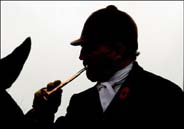
by Mark Burns
Buttercup hooves the sod in her paddock, bowing her head gently as I approach. She’s so unlike the other horses; silent and placid, standing apart in her storybook beauty.
“Do you know how to ride?” asks a smiling woman in flattering jeans and a baseball cap, her own blonde ponytail playing in the afternoon sunlight. She fits Buttercup with a saddle as my tongue seizes up in the back of my throat, speech crippled by a teenage hormonal fit.
“I had some riding lessons in 4-H. But it’s been awhile,” I say, gathering my slackened jaw to stumble through a sentence.
I had taken occasional lessons for a little over a year during middle school, but I never rode past a trot. My training horse, Stormy, was a stubborn twit; you almost needed a cattle prod to get him moving. I never graduated to a better horse, for I ended my lessons abruptly after seeing the instructor’s daughter in a cast. A horse had snapped her foot under hoof in the training pen.
“I’m pretty rusty.”
Buttercup’s attendant smiles broadly. “You remember the basics, right? It’s like riding a bike.”
If she says so.
The equestrienne secures the saddle and I mount up neatly. “See? It’s easy,” she says, and offers the prized Buttercup as my rented steed.
I amble the horse to the back of our youth group’s riding train, surprised by how easily Buttercup handles. But as the trainer sets out, my mind blanks, and I tug at the reins while prodding with my heels. Buttercup jerks forward in starts and stops, shaking her head in frustration. I dig my heels deeper. Seeing my trouble, a guide breaks off. “You’re giving her mixed signals,” he calls back, sparking memory. I slacken the reins.
Buttercup bursts into a trot, bouncing me in the saddle as she whizzes past the guide. My appendages flap haphazardly, each accidental slap of heels and reins spurring Buttercup past gallop into warp speed. The train of 20 whips by as a peripheral blur, disappearing as Buttercup’s speed threatens to launch me right out of West Virginia’s panhandle. Reaching deep down for control, I find only frightened curses.
‘Horse People’
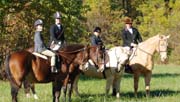
“‘S#*@! is not a command!”
An angry bellow breaks through the whoosh of wind in my ears as the lead guide gallops alongside, gesturing for me to pull back on the reins and bring my feet under control. The haze of fear parts to the light of comprehension, and I am stopped. I ride back, separated from the train, flanked by two guides — like an outlaw being delivered by deputies to the gallows.
Such was the climax to my equestrianism. My bruised hindquarters have visited no saddle since. I came to accept that I, like my family, would perhaps never join the horse people.
It’s not as though we didn’t try. When Mom inherited a small parcel of farmland in the 1980s, we entertained the idea of getting a horse. (There was also the naïve idea of taming a wayward fawn that was momentarily closeted up in the old chicken coop, but that’s another story.) After the reality of a few care-and-feeding classes, we balked and limited livestock to our dog. Riding lessons did little to educate my ignorance.
We became content to be neighbors of horse people, admiring from across the fence as horses grazed in the near pasture. Ours was a peaceful coexistence, uneventful aside from the occasional manure breeze and the birthday party when guests were enlisted to help find a thrown rider lost in the woods.
Peace would not last. Tension mounted as our neighbor took to hosting equestrian events. Trucks and trailers gathered on the grassy border between our properties for dressage meets, leaving Pop grumbling of wheel ruts and horse divots. His ire grew. During one event, he bounded out to the property line aboard his Ford lawn tractor, marking territory with orange traffic cones. Mom and I watched from the dining room picture window with some embarrassment as he ordered the horse people to move their rigs back across the line.
In the fall, after nearby farm fields were cleared for harvest, our neighbor sometimes staged a fox hunt and party, drawing riders from across Southern Maryland. Mom, Pop and my nearby grandmother always received invitations in the mail. Included was a postscript that accepting the invitation meant forfeiting all claims from horses crossing one’s land.
“Such gall,” my family would say.
“So inconsiderate,” they would later harrumph, as horses crossed anyway. Riders took great care to hug the roadside and tread gently on the inevitable transect, though tails would just as inevitably rise and drop fresh horse plops to fill hoof divots.
So it came to be that the fox hunt was a fat wedge between our unhorsed family and the horse people. But as they toed across our driveway, I wondered. Just what is this sport really about?
My Hunt: Part 1
Sunlight gleams from a blue sky on this beautiful autumn day, red and yellow leaves swirling across the paved country road as I wend my way to Grammy’s house for a family birthday party. Curving through a stand of oaks, I exit the dapple of shade to find a group of riders ahead. I slow down for a look-see.
Tally Ho
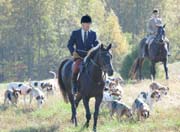
Fox hunting is one of those old-world sports, a British tradition of pest control with roots in the 1500s. Hunters trained packs of dogs to sniff out and destroy the fox, a predator considered so disruptive that its bounty was up to 12 times higher than that on lowlier pests. The grounded hunters eventually mounted up and made sport of it. Through the 1600s, foxes gradually stood in for stags, as deer hunting became difficult across lands evermore segmented by walls and hedgerows.
The colonies’ first foxhounds arrived in Maryland with Robert Brooke and family in 1650. Hunts grew popular across Maryland and Virginia and spread. George Washington himself stalked fox, and hounds once sniffed trails across Capitol Hill. By the 1700s, fox hunting had become a proud and popular sport thriving on either side of the Atlantic.
Now the British hunt is itself the quarry. British animal rights groups holed hunters by winning passage of the 2004 Hunting Act, banning fox hunts in England and Wales. Riders fought to preserve rights to their countryside tradition, but Britain’s High Court held up the ban, which went into effect last February 18.
Some 200 hunt clubs across Britain defied the ban in early November, the traditional start of hunting season, skirting the law with a fox’s cunning. Many used the approved alternative of riding after an artificial scent trail. At least 50 clubs took up falconry, using dogs to flush out fox for the birds to kill.
American hunts, meanwhile, enjoy a less contentious existence. In fact, popularity steadily grows as more people mount up. The nearly century-old Masters of Foxhounds Association of North America — stateside fox hunting’s Virginia-based governing body — counts 171 clubs in 40 states and Canada, with nine here in Maryland. Virginia boasts 28, by far the most of any state. “It’s the mecca of foxhunting,” says Dennis Foster, executive director of the association.
Clubs can be found along the East Coast, south to Alabama and Florida and west to California and Wyoming. Expansive coyotes — fox-feeders encroaching as near as Davidsonville — have become new quarry for some clubs, a distinct challenge for their all-out beeline flight so different from the foxes’ crafty switchbacks.
Coyotes aren’t the only element that sets American hunts apart from British. There is a world of difference between the hunts of Britain and America, and Foster — who has ridden with 300 hunts in 11 countries — is tired of his sport being saddled by stereotype.
“It’s a huge misconception by the public,” he says.
My Hunt: Part 2
It’s a scene sprung from a museum wall, a composition neatly lifted from the oils of an old English painting. Equestrians wear the formal riding uniforms of black helmets, red jackets, white breeches and black boots. A couple are dismounted and sifting through a cluster of tall grass near the shoulder. One man, whom I presume to be the master of the hunt, sits in his saddle, holding the reins and a brass horn in his left hand, brushing tall grass aside with a riding whip in his right. Hounds root through the grass, a busy jumble of spotted backs and wagging tails barely visible in the brush. A curious nose occasionally pops up to scent the breeze.
Meet the Hunters
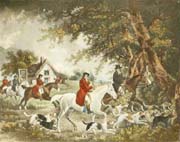
Foxhunting is popularly considered a sport of the elite. Imagine the archetype, and you might see titled heirs dressing to the nines for a proper romp through the countryside before adjourning to an oak-paneled manor for expensive brandy and cigars. Some minds take it further. In the B-movie Omen III: The Final Conflict, Lucifer’s own son chased fox, with Sam Neill dispatching his hounds to devour a Christian.
In truth it’s not quite so.
“We’ve got all walks of life,” says Cynthia Clagett, 51, joint master of the hunt for Chesapeake Country’s Marlborough Hunt Club. “There’s the expense of the horse, of course. But anyone who loves riding comes out. That elitist stuff is once again the English versus American idea. People have images of the lords and ladies riding around in their scarlet coats and stuff.”
The hunt clubs, Foster agrees, are much more inclusive than popular opinion would have it. “It’s not a rich sport,” he says. “Most are just regular, middle-class people who can afford a horse.” Many riders, like Clagett, come from agrarian roots, growing up with a fondness for the land and its animals.
While British hunts may have evolved closer to the stereotype, what with royal titles and a higher premium on land, American hunts are decidedly democratic. Masters of the hunt are decided by vote, not by wealth or lordship. All ages and riding abilities are welcome, with riders divided into three fields depending on skill. The first, fast field stays right with the dogs; the second field avoids jumps or hard running; and riders in the third field (or hilltoppers, as Clagett’s club terms them) follow on horse at a walk or trot.
During the full season, running from November to March, hunts might last three hours. At Marlborough Hunt Club, some three dozen riders head out twice weekly. (Large hunts, such as in Virginia, are known to attract 150 or more riders.) One hunt is run during the week, with riders wearing informal uniforms, perhaps tweed jackets. Weekends are more formal, as riders break out the more recognizable garb.
A sharp dress code keeps tradition alive, but it’s also practical. The helmet is obvious. Tall leather boots protect against brambles, as does the seasonally heavy woolen jacket: scarlet for hunt staff, dark blue or black for the riders. Even the pouffy stock tie pinned behind the collar has purpose; in case of injury to the horse or rider it can be used as a bandage or sling.
Of those draped scarlet, the master of the hunt handles the pack, using the traditional brass horn to bridge communication between human and hound. Separate notes mark when hounds are on scent (going away), when the fox has been chased to its burrow (gone to ground) or when the hunt is breaking off (going home). Today, walkie-talkies and radios are often used in lieu. Four whips act as scouts along the periphery, to spot any sign of a fox escaping the hunt area. The call tally ho signals a sighting. Whips also converge to help reign in the dogs should a fox lead them too near a road.
What about the Fox?
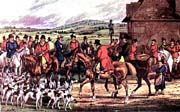
In terms of agility and cunning, foxes have the advantage over dogs, typically opening up wide leads and seeming to enjoy the game on their terms.
Clagett was riding as a whip, stationed atop a hill scouting the periphery, when she saw two foxes exit woods’ edge and sit together, scratching. “They started looking at each other, got up, then crisscrossed the field,” she says, a smile in her voice. “They were just laying this incredibly difficult scent. The hounds took 20 minutes to figure it out.
“The fun of fox chasing,” says Clagett, “is seeing how the fox leads the hounds in a merry chase. They get away easily.”
Dogs have got to learn what seems to come naturally to foxes. In the warm-up season, from September to late October, hounds are trained to work as a group in chases that might last one and a half hours Each hound has a role. The lead dog gets gung-ho and is first on the scent, leading the pack along. A steady dog is more careful about keeping true to the scent trail. Slower backup dogs will get the pack back on track when it’s lost the scent.
Clagett’s club, based in Upper Marlboro, follows about three dozen hounds out of seven fixtures — or starting points for chases — throughout parts of Anne Arundel, Calvert and Prince George’s counties. The chase territory usually bounds across neighboring farms, sharing land for sport. Each fixture is a known fox habitat, and the hounds simply pick up the trail of foxes already there. Foxes are not trapped elsewhere and imported for the chase. Nor is all the action focused on one fox. Each chase picks up the trails of multiple foxes; in Marlborough territory the best foxes lead chases up to 50 minutes long.
The starkest contrast between British and American hunts lies in the fox’s fate. The tree-dappled sweeps of American hunt territory provide cover for the fox at bay. England’s clear-cut sweeps of land can spell death for a fox on a headlong, miles-long rush between wooded cover.
“In England when you’re riding,” says Clagett, “farmers come up asking, ‘Did you kill that fox?’” Europeans consider fox a regular infestation, a populous and menacing pest. But American foxes are more scattered and far less an annoyance. Thus American clubs generally do not kill the fox. In fact, they preserve it. Their sport is actually chase, not hunt.
Chasers have an interest in keeping the best foxes around for more fun, and to that end they both monitor fox dens and distribute rabies and worming medicine. Kills are rare state-side, usually eliminating only foxes that are sick, lame or old.
“People have this standard image of us trying to send fox to a skyward place,” says Clagett. “They don’t realize how much we care for them. Everybody’s doing it because you want to maintain the population.”
My Hunt: Part 3
I had seen the preparations of our equestrian neighbor before, but never the hunt in action. It enthralls my curiosity as I become a tourist one mile from home. For the first time, I get a positive sense of what it must be like. A brisk, challenging ride among friends on a crisp autumn day with good dogs, crafty quarry and a trusty steed leading you on an adventure over hill and dale. Fresh memory is still folding itself into my mind as I return eyes to the road.
Why Chase?
Clagett has been a master of the hunt since 2000 and chasing fox since she was 12. “It’s so beautiful,” she says. “You get to go out into the fresh air and go out in the countryside. See the way the hounds will run.” She speaks of fox fondly, admiring their cunning, and sees a symbiosis in the chase.
Fox hunters are animal lovers, says Foster, who relish a dynamic rivalry. “They love to be on the horse and love to watch the fox and the hounds, who’ve been adversaries from their very existence,” he says.
There is more to love apart from saddle. Dismounted, huntsmen compete for bragging rights in horn-blowing competitions. Dogs are central to the hunt’s existence, and enthusiasts enjoy a busy dog show circuit for the hounds. One of Marlborough Hunt Club’s dogs came close to top honors at a recent Virginia show. The hunt is also a nexus for equestrians, who continue their friendships apart from the chase and involve whole families in the sport. Foster says riders range in age from five to 90.
My Hunt: Part 4
THUMP-UMP. My gaze returns to the road just as a red blur darts by. My insides roil with the gut-wrenching jolt of animal under wheels. In the rear-view mirror, hunters and dogs gawp in disbelief at the tumbling form. I cruise on in shock, then chance another rear-ward glance. The hunt’s master tenses upright in his saddle, gob-smacked with mouth agape and face blank.
Their chase is ended.
A hundred feet farther down the road I pull into the driveway and dart like a fox into the warm, safe burrow of my grandmother’s home. Should I have stopped? Should I go back? Will they come knocking with reprimand?
Was it a dog? It would be horrible if it was a dog. No. It couldn’t have been. The animal was distinctly small and red, and well apart from the tight pack of hounds. It had to be the fox.
I relate my story to shocked laughter and stunned looks. Grammy, it would seem, had recently come inside from assessing divots and plops. We sink heads in a brief quiet to mark the fox’s passing. At least it was a quick end, better than our imagined canine rending. We surmise, in ignorance of rules, that I won the hunt.
For Love of the Fox
“We have a dead hunts file that’s pretty large,” says Foster.
Unlike Britain, it isn’t legal troubles that hound American riders. Kills in American-style chasing are rare enough that Maryland’s Department of Natural Resources, for one, considers it a sport beyond the domain of hunting restrictions. Animal rights groups, such as People for the Ethical Treatment of Animals, complain of chases’ cruelty. Foster counters that his Masters of Foxhounds Association closely monitors hunts for humane standards and is active in protecting the species through preservation efforts. If a hunt club chooses to kill, it must be done swiftly. Foster touts the carnivorous respect of hunters’ ethics: wear them, eat them, love them.
It’s for love of the fox and the hunt that Foster’s association confronts the hunts’ biggest threat, sprawl. Unchecked expansion is swallowing up open spaces and has forced many hunts to close while squeezing fox habitat. Collisions such as the fox kill of my teenhood are a mounting danger as local roads bustle with denser, faster traffic. Foster advocates smart growth and preserving open space.
Even with moderated growth, chasers still run into fences.
“For people who live in a farming community, there’s a sharing of resources,” Clagett says. Newcomers may not be so open-space minded about their hard-won piece of country.
It’s a divide likely to increase as suburbia chafes against agraria. In Anne Arundel and Calvert counties, equestrian culture continues to grow, with more horse farms joining the landscape. The U.S. Department of Agriculture’s latest census, in 2002, found that in Maryland, 88 new horse and pony farms opened between 1997 and 2002 for a total of 3,166. That number doesn’t include the total 20,200 “equine places,” meaning any spot where equines — horses, mules or donkeys — are kept for recreation, commerce or sport. Anne Arundel alone had 1,330 such places with 4,590 horses (of every walk from Shetland pony to draft horse) as of 2002; Calvert counted 420 places with 1,510 horses.
The region’s equine culture may win yet another boon. The Maryland Stadium Authority is pushing for a horse park to be built on the site of the U.S. Naval Academy’s 875-acre dairy farm in Gambrills, presently the highest profile proposal for Anne Arundel’s hotly contested pocket of open space. But the Navy still hasn’t signed over a lease for the property, leaving the options wide open.
So should a hunt ride through your neighborhood and you feel the chafe, perhaps consider the chaser’s point of view. Remember that shoulders are public right of way. If a horse deposits unwanted fertilizer, it’s merely a call of nature, not some rider’s dastardly intention.
After all, s#*@! is not a command.

